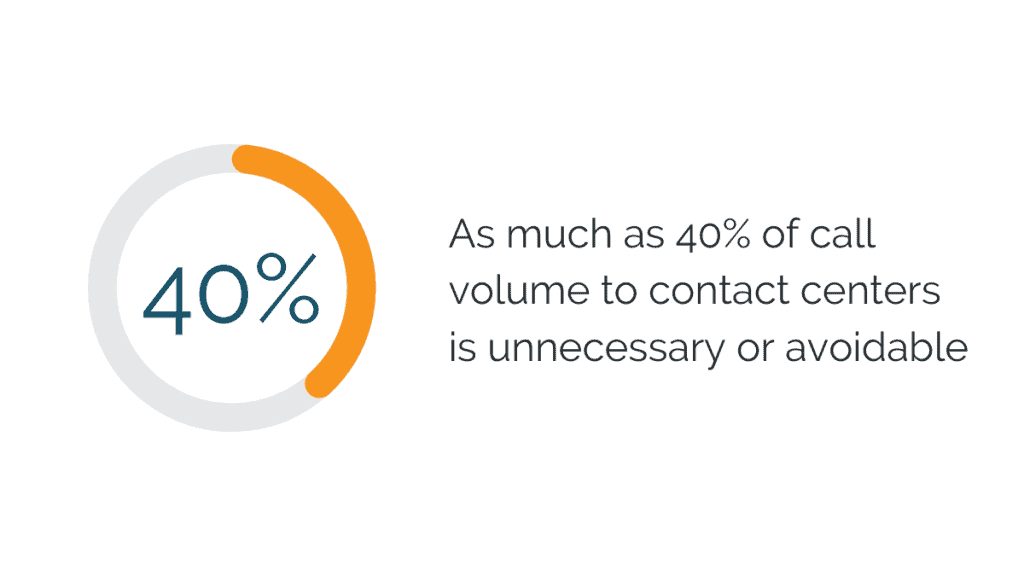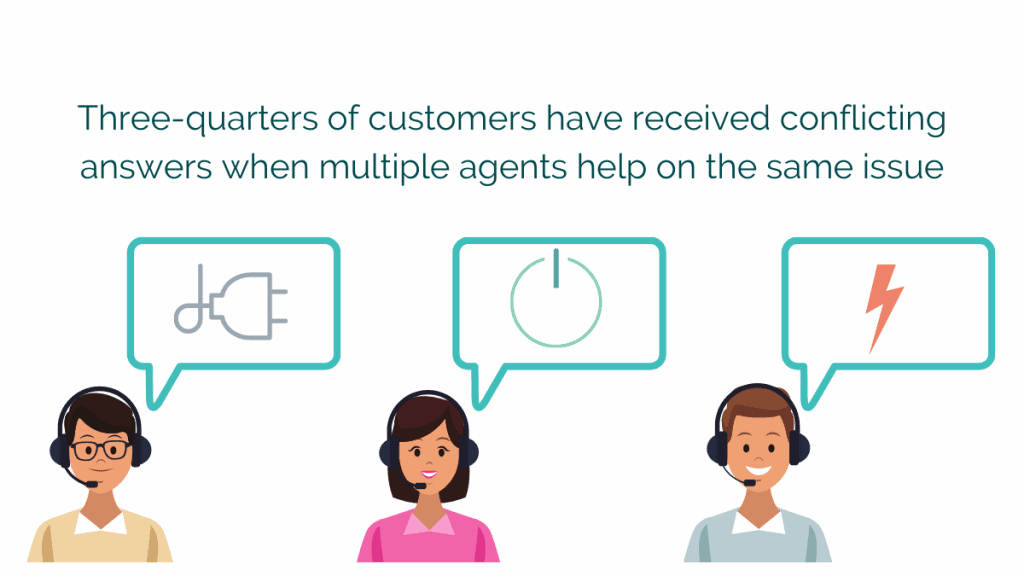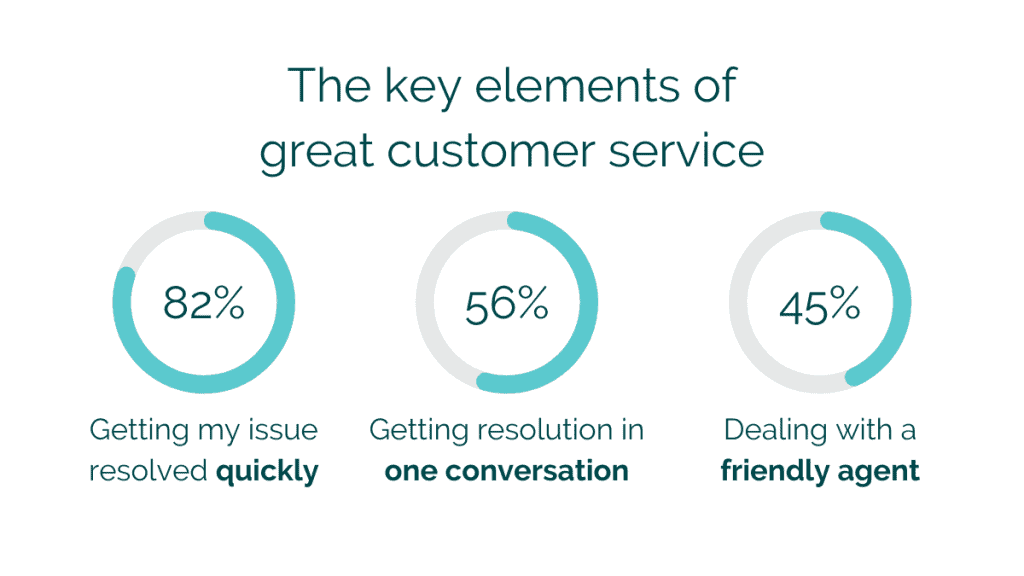Transferred calls aren’t always due to routing system failure – sending customers to other agents is sometimes unavoidable.
But if your Call Transfer Rate (CTR) is high, you may not be routing customers to the correct help when they contact you.
The good news is there’s a simple answer to this problem: automation.
(Want more articles like this in your inbox? Click here to get our fortnightly CX newsletter.)
What are transferred calls?
Transferred calls happen when an agent routes an inbound call to another agent. They typically occur when the first rep is unable to solve the customer’s problem.
Common reasons for transfers include:
- The call was routed to the wrong person or department.
- The caller requires specialized help the agent can’t provide.
- The call gets escalated to a more senior employee.
Call transfers are an unavoidable part of operating a contact center. But most businesses try to keep call transfer volume as low as possible for two main reasons:
- Transferred calls result in frustrating customer experiences. Callers have to repeat information to multiple agents, and they spend more time on hold than necessary. These are two activities studies show customers hate.
- Transferred calls use more resources. It takes longer for your contact center to solve a problem, and multiple agents are involved in the process.
Simply put, fewer transfers result in happier customers and more cost-effective call center operations.

The two types of call transfer
If you have to do call transfers, do them the right way. This means making warm transfers, not cold ones. The former type of transfer typically results in a much better customer experience.
Cold transfers
Cold transfers are when the agent who receives the transferred call knows nothing about the caller.
The customer needs to explain their problem to an agent who has no idea who they are.
It’s not an ideal situation for either party:
- The customer has to repeat their problem to the new agent.
- The call takes longer than it otherwise would.
- Agents have to deal with frustrated customers.
Warm transfers
Warm transfers are a better solution.
In this situation, the first agent passes on information about the caller to the second one. The receiving agent has everything they need to deal with the issue.
You can do warm transfers manually. The first agent puts the customer on hold and then explains the problem to the receiving agent.
Or you can integrate technology like your CRM and helpdesk into your contact center. These platforms send relevant customer information along with the call.
A no-code platform can help you create processes that do this automatically.

Fewer transferred calls means better metrics
Reducing call transfers can have a direct impact on essential customer support metrics.
On their own, these metrics don’t measure the quality of your support. But they are useful guidelines.

Call Transfer Rate
Your Call Transfer Rate (CTR) shows the percentage of the calls your contact center receives that you end up transferring.
A low CTR suggests that callers are getting through to the right person. A high rate means you may need to implement better routing processes.
First Contact Resolution
First Contact Resolution (FCR) is the number of calls that are solved on first contact.
A low FCR means the customer received the help they needed right away. It means you didn’t transfer them to another agent, and they didn’t call up again about the same problem.
Average Handling Time
Average Handling Time is the average amount of time it takes your team to deal with customer requests.
Reducing call transfers tends to cut down on hold time and repetition. This can reduce the time customers spend on a call.
Customer Experience
Not having to transfer can result in a better customer experience.
Why is that important?
Well, reports suggest that 32% of customers will stop doing business with a brand they love after one bad experience. And 59% of those in the U.S. will walk away after several.

The key to fewer transferred calls? Better call routing
Warm call transfers are better than cold call transfers. But it’s best if you don’t have to transfer the caller at all.
The key to this is routing your calls to the correct person in the first place. Automatic Call Distribution (ACD) and conversational IVR technology can help.
Here’s how:
Location-based routing
Location-based routing identifies a caller’s location and then routes them to an appropriate team.
It helps callers get through to relevant agents if you offer support in multiple languages or if your service has regional differences.
Status-based routing
Status-based routing is when you use customer information to route customers to the correct department.
Imagine a customer contacted your team via a website chatbox but couldn’t resolve their issue.
When they call your contact center using a phone number associated with their account, your system spots the open ticket. It then automatically routes them to a relevant agent.
Campaign-based routing
Campaign-based routing ensures people are routed to a relevant agent when they call about a marketing offer.
This form of routing ensures the caller’s first experience with your company is positive. The agent knows why the person is calling and can help them take steps towards becoming a customer.
Contact-centers can install campaign-based routing by setting up multiple phone numbers – each one corresponding to an individual campaign.
When a customer calls a particular number, they are routed to an agent who is assigned to the campaign.

VIP call routing
Some accounts are worth more than others. Knowing your most valuable customers lets you provide them with specialized service.
To set up VIP call routing, you need to define the criteria that make someone a VIP customer.
This could be:
- How much they have spent with your business.
- Their role in their company. Send people with the power to make buying decisions directly through to your team.
- Prospects who are showing signs of being ready to make a purchase.
- Customers approaching their subscription renewal date.
Once you’ve defined this information, you need to decide what to do with those who meet the criteria. It could be as simple as putting them at the front of your contact center queue. Or it could be routing them to highly skilled agents.
Conversational IVR
From a customer’s point of view, the main issues with traditional IVR are that they have to listen to irrelevant options and that the reason they’re calling isn’t listed.
This invariably leads to them speaking to the wrong person.
Conversational IVR helps by improving the way contact centers capture caller intent.
Instead of listening to a list of options, the caller states why they are calling. Then Natural Language Understanding (NLU) deciphers this speech and sends the caller to the most relevant agent.
No-code is the easy way to contact center automation
No-code platforms simplify setting up the type of automation mentioned in this article.
It requires little more than connecting the relevant services and then selecting pre-made automation.





